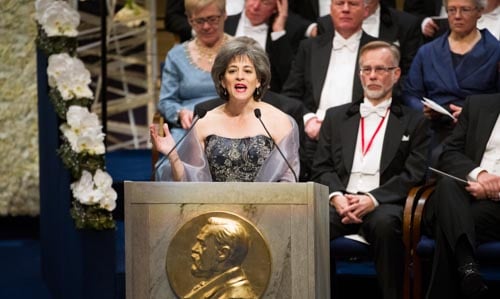Award ceremony speech
Presentation Speech by Professor Juleen Zierath, Member of the Nobel Assembly at Karolinska Institutet, Chairman of the Nobel Committee for Physiology or Medicine, 10 December 2013

Professor Juleen Zierath delivering the Presentation Speech for the 2013 Nobel Prize in Physiology or Medicine at the Stockholm Concert Hall.
Copyright © Nobel Media AB 2013
Photo: Alex Ljungdahl
Your Majesties, Your Royal Highnesses, Esteemed Laureates, Ladies and Gentlemen,
Imagine this Nobel Prize Award Ceremony without any of the beautiful flowers that you can see here around me. These flowers are transported to Stockholm each year from Sanremo in Italy. But imagine if they were missorted and ended up in Copenhagen. Without a functioning transport system, this could easily be a reality. To avoid chaos, we are totally dependent on fine-tuned transport systems, where cargo is loaded into the right vehicle and transported to the right destination at the right time.
The cell, with its different compartments, faces a similar transport challenge. Each cell in the body functions like a factory, producing molecules, which are delivered to specific locations at exactly the right moment. Bubble-like vesicles carry the molecules between different compartments in the cell. One of the great mysteries of cell physiology was how these vesicles could be delivered to the right destination at the right time. And how was this process controlled with temporal precision?
In the 1970s, Randy W. Schekman was fascinated by these questions. He studied vesicle transport using yeast as a model. He identified yeast cells with defective transport machinery. These cells showed a resemblance to a poorly planned public transport system: similar to a situation in a bustling city, when trains cannot depart from the station due to rail defects. Consequently some passengers pile up at the station and others get routed to new destinations. In Schekman’s experiments, vesicles piled up in certain parts of the cell. He found that the cause of this congestion was genetic and went on to identify the mutated genes. By these groundbreaking experiments, Schekman provided new insight into the tightly regulated machinery that mediates vesicle transport in the cell.
James Rothman was also intrigued by the nature of the cell´s transport system. While studying vesicle transport in the 1980s and 1990s, he discovered a protein complex that enables vesicles to dock and fuse with target membranes. In this fusion process, proteins on both the vesicle and the target membrane bind to each other like two sides of a zipper. The fact that there are many such proteins and that they bind only in specific combinations guarantees that cargo is delivered to the right destination. In these elegant experiments, Rothman revealed how vesicles, using this zipper-like function, are able to locate the correct docking site in the cell. Cargo, like these flowers around me, could be delivered to the right location!
But questions still lingered. How are molecules released from vesicles in such a precise manner? Thomas Südhof was interested in how nerve cells communicate with one another in the brain. The signalling molecules, neurotransmitters, are released from vesicles using the machinery discovered by Rothman and Schekman. In the 1990s, Südhof searched for calcium sensitive proteins that control this process. He identified molecules that sense calcium ions and trigger vesicle fusion. This allows the zipper to open so that cargo can be released. Südhof’s electrifying discovery explained how vesicles can rapidly release their cargo on command. Neurotransmitters are delivered with temporal precision from nerve cells, just like these flowers could be delivered to this Nobel Ceremony on the right day.
The 2013 Nobel Laureates have discovered a truly fundamental process in cell physiology. Their discoveries have had a major impact to advance our understanding of how molecules are correctly routed to appropriate destinations in the cell with timing and precision. Without this wonderfully precise mechanism, we would not survive. This process is required for sending neurotransmitter substances from one nerve cell to another, as well as for the release of hormones, such as insulin, to control blood sugar after a meal.
Professors Rothman, Schekman and Südhof,
With brilliant experiments, you have solved one of the great mysteries of cell physiology. Your discoveries represent a paradigm shift in our understanding of how the cell organises the routing of molecules packaged in vesicles to various cellular destinations. Specificity and timing in the delivery of molecular cargo are essential for our survival.
On behalf of the Nobel Assembly at Karolinska Institutet, I wish to convey to you our warmest congratulations. May I now ask you to step forward to receive the Nobel Prize from the hands of His Majesty the King.
Nobel Prizes and laureates
Six prizes were awarded for achievements that have conferred the greatest benefit to humankind. The 14 laureates' work and discoveries range from quantum tunnelling to promoting democratic rights.
See them all presented here.
